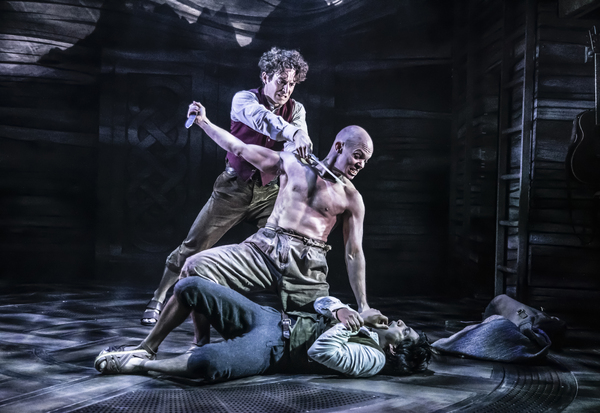
What’s On Stage
5 stars out of 5
The Lord of the Rings musical review – The Tolkien revival makes for epic and timely theatre
The Shire has come to leafy Newbury!
You may well have read the book, seen or heard the film and radio adaptations, or you may have experienced the previous West End production, but this extraordinary retelling at the Watermill Theatre draws its audience into the narrative like no other medium I have experienced. The story is told with such clarity and verve, you won’t get lost on the epic journey, adapted for the stage by Shaun McKenna and Matthew Warchus and directed here by Paul Hart.
The performance begins at the outdoor stage with an invitation to senior hobbit Bilbo Baggins’ (John O’Mahony) eleventy-first (111th!) birthday party. Members of the audience are encouraged to join a game of quoits with the company of actor/musicians, creating a joyously immersive atmosphere.
To the cheery accompaniment of the all-singing and dancing company of 20 and the helpful front of house marshals, we are guided in colour-coded groups around seemingly every part of this singularly beautiful lawned venue before entering the auditorium. There we embark on a quest to defy and defeat the Dark Lord Sauron alongside the tribes of Middle-earth: elves, dwarves, men and, of course, the small but valiant hobbits. The wizards Saruman the White and Gandalf the Grey advise and guide the players with their wisdom and power.
Set and costume design, lighting, sound and projection, choreography, puppetry and fight direction work seamlessly and with wondrous imagination to tell the sweeping tale in little more than three hours. Designer Simon Kenny’s indoor set is breathtaking, deceptively simple at first, but so versatile. Good and evil dominate in turn, depending on subtle shifts thanks to lighting designer Rory Beaton and projection designer George Reeve.
Adam Fisher’s soundscape adds terror, suspense and beauty, blending perfectly with the music by A R Rahman, contemporary Finnish group Värttinä and Christopher Nightingale, all played on instruments by the multi-talented cast themselves. This continues the Watermill tradition of showcasing actor-musicians at the heart of many of its productions.
Peter Marinker makes a sympathetic wizard as Gandalf, combining real affection with a spot of patronising of his earthly charges and all the subtle hints of frustration when he finds himself wanting. His sense of where he is in the pecking order when it comes to the more ethereal magic of the Elvish queens in particular is clear and vivid. Georgia Louise is a calm and commanding Galadriel, while Aioife O’Dean’s far-sighted Arwen is acutely aware of what it means to love a mortal, given her supernatural pedigree.
Tom Giles effectively doubles up as the cold and sinister Saruman – belying his appellation ‘The White’ by ruthlessly unleashing his swarms of orcs, fiendish in their unpredictably frightening movement quality and horribly harsh cries – and as a commanding Elron, leader of the Elves.
Folacin Akinmade has wonderful physicality as brave down-to-earth Gimli the dwarf, contrasting nicely with noble and equally brave men, Aragorn (Aaron Sidwell) and Boromir (Peter Dukes). Legolas the archer (Yazdan Qafouri) is a deadly accurate foe, practical and just ‘faerie’ enough. Matthew Bugg’s obsessed, twisted and agonised Gollum earns pity as well as disgust and irritation from the audience.
Last but by no means least are the hobbits. O’Mahoney’s Bilbo Baggins is hunched and determined. The central pairing of Frodo (Louis Maskell) and Sam (Nuwan Hugh Perera) is touchingly convincing, thanks to Maskell’s rather otherworldly interpretation and Perrera’s extraordinarily sympathetic, courageous and practical turn. Finally, Geraint Downing and Amelia Gabriel offer light relief with their delicious double act as Merry and Pippin, respectively.
The Ent known as Treebeard, one of the spirits of the trees, also plays a role in the production, appropriately represented by a mighty voice. The Ents are part of Tolkien’s engaging with ‘green’ issues, making his narrative so urgently topical today. Saruman’s master plan is to cut down the trees, destroy Treebeard’s habitat and use the land to build on and the timber as materials. His ravages target the Shire, the gentle evocation of the English countryside that is home to the hobbits. So, as well as being extraordinarily exuberant and inclusive, this production had found its time and purpose too. Tolkien would have been so proud.